Postpartum Hemorrhage post Placenta previa Centralis-Conservative Management. A case report
VerifiedAdded on 2023/06/07
|6
|3029
|351
AI Summary
This article discusses a case report of a 31-year-old woman who presented with signs and symptoms of Placenta previa and later developed postpartum hemorrhage (PPH). The diagnosis of Placenta previa was based on symptoms and sign as continuous bleeding ‘ex utero’, clots in vagina, uterine atony and distended bladder. Using a conservative treatment such as the application of uterotonic drugs and uterine massage, the uterus was saved. The article also discusses the complications associated with Placenta previa and the risk factors that favor its development.
Contribute Materials
Your contribution can guide someone’s learning journey. Share your
documents today.
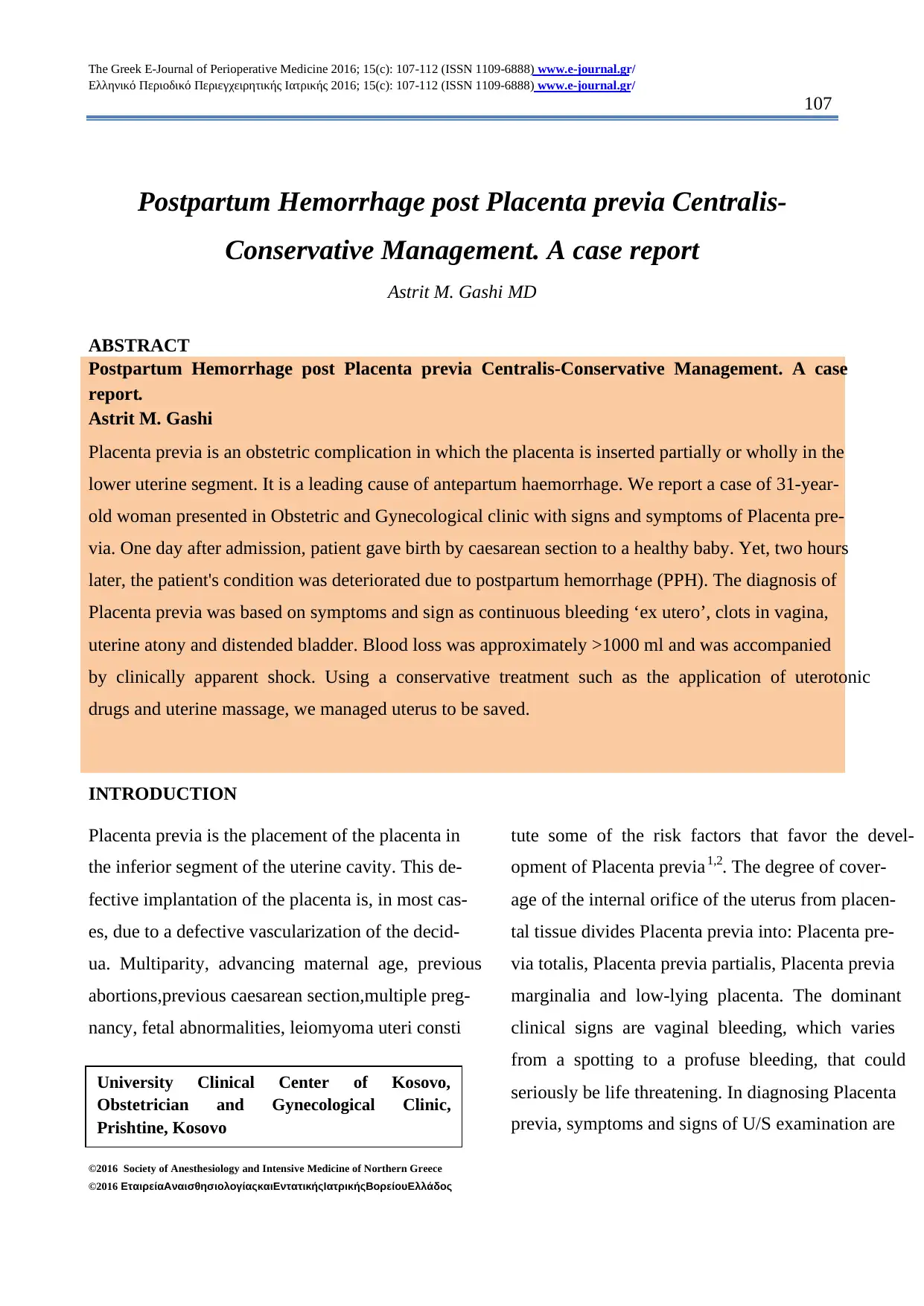
The Greek E-Journal of Perioperative Medicine 2016; 15(c): 107-112 (ISSN 1109-6888) www.e-journal.gr/
Ελληνικό Περιοδικό Περιεγχειρητικής Ιατρικής 2016; 15(c): 107-112 (ISSN 1109-6888) www.e-journal.gr/
107
©2016 Society of Anesthesiology and Intensive Medicine of Northern Greece
©2016 ΕταιρείαΑναισθησιολογίαςκαιΕντατικήςΙατρικήςΒορείουΕλλάδος
University Clinical Center of Kosovo,
Obstetrician and Gynecological Clinic,
Prishtine, Kosovo
Postpartum Hemorrhage post Placenta previa Centralis-
Conservative Management. A case report
Astrit M. Gashi MD
ABSTRACT
Postpartum Hemorrhage post Placenta previa Centralis-Conservative Management. A case
report.
Astrit M. Gashi
Placenta previa is an obstetric complication in which the placenta is inserted partially or wholly in the
lower uterine segment. It is a leading cause of antepartum haemorrhage. We report a case of 31-year-
old woman presented in Obstetric and Gynecological clinic with signs and symptoms of Placenta pre-
via. One day after admission, patient gave birth by caesarean section to a healthy baby. Yet, two hours
later, the patient's condition was deteriorated due to postpartum hemorrhage (PPH). The diagnosis of
Placenta previa was based on symptoms and sign as continuous bleeding ‘ex utero’, clots in vagina,
uterine atony and distended bladder. Blood loss was approximately >1000 ml and was accompanied
by clinically apparent shock. Using a conservative treatment such as the application of uterotonic
drugs and uterine massage, we managed uterus to be saved.
INTRODUCTION
Placenta previa is the placement of the placenta in
the inferior segment of the uterine cavity. This de-
fective implantation of the placenta is, in most cas-
es, due to a defective vascularization of the decid-
ua. Multiparity, advancing maternal age, previous
abortions,previous caesarean section,multiple preg-
nancy, fetal abnormalities, leiomyoma uteri consti
tute some of the risk factors that favor the devel-
opment of Placenta previa1,2. The degree of cover-
age of the internal orifice of the uterus from placen-
tal tissue divides Placenta previa into: Placenta pre-
via totalis, Placenta previa partialis, Placenta previa
marginalia and low-lying placenta. The dominant
clinical signs are vaginal bleeding, which varies
from a spotting to a profuse bleeding, that could
seriously be life threatening. In diagnosing Placenta
previa, symptoms and signs of U/S examination are
Ελληνικό Περιοδικό Περιεγχειρητικής Ιατρικής 2016; 15(c): 107-112 (ISSN 1109-6888) www.e-journal.gr/
107
©2016 Society of Anesthesiology and Intensive Medicine of Northern Greece
©2016 ΕταιρείαΑναισθησιολογίαςκαιΕντατικήςΙατρικήςΒορείουΕλλάδος
University Clinical Center of Kosovo,
Obstetrician and Gynecological Clinic,
Prishtine, Kosovo
Postpartum Hemorrhage post Placenta previa Centralis-
Conservative Management. A case report
Astrit M. Gashi MD
ABSTRACT
Postpartum Hemorrhage post Placenta previa Centralis-Conservative Management. A case
report.
Astrit M. Gashi
Placenta previa is an obstetric complication in which the placenta is inserted partially or wholly in the
lower uterine segment. It is a leading cause of antepartum haemorrhage. We report a case of 31-year-
old woman presented in Obstetric and Gynecological clinic with signs and symptoms of Placenta pre-
via. One day after admission, patient gave birth by caesarean section to a healthy baby. Yet, two hours
later, the patient's condition was deteriorated due to postpartum hemorrhage (PPH). The diagnosis of
Placenta previa was based on symptoms and sign as continuous bleeding ‘ex utero’, clots in vagina,
uterine atony and distended bladder. Blood loss was approximately >1000 ml and was accompanied
by clinically apparent shock. Using a conservative treatment such as the application of uterotonic
drugs and uterine massage, we managed uterus to be saved.
INTRODUCTION
Placenta previa is the placement of the placenta in
the inferior segment of the uterine cavity. This de-
fective implantation of the placenta is, in most cas-
es, due to a defective vascularization of the decid-
ua. Multiparity, advancing maternal age, previous
abortions,previous caesarean section,multiple preg-
nancy, fetal abnormalities, leiomyoma uteri consti
tute some of the risk factors that favor the devel-
opment of Placenta previa1,2. The degree of cover-
age of the internal orifice of the uterus from placen-
tal tissue divides Placenta previa into: Placenta pre-
via totalis, Placenta previa partialis, Placenta previa
marginalia and low-lying placenta. The dominant
clinical signs are vaginal bleeding, which varies
from a spotting to a profuse bleeding, that could
seriously be life threatening. In diagnosing Placenta
previa, symptoms and signs of U/S examination are
Secure Best Marks with AI Grader
Need help grading? Try our AI Grader for instant feedback on your assignments.
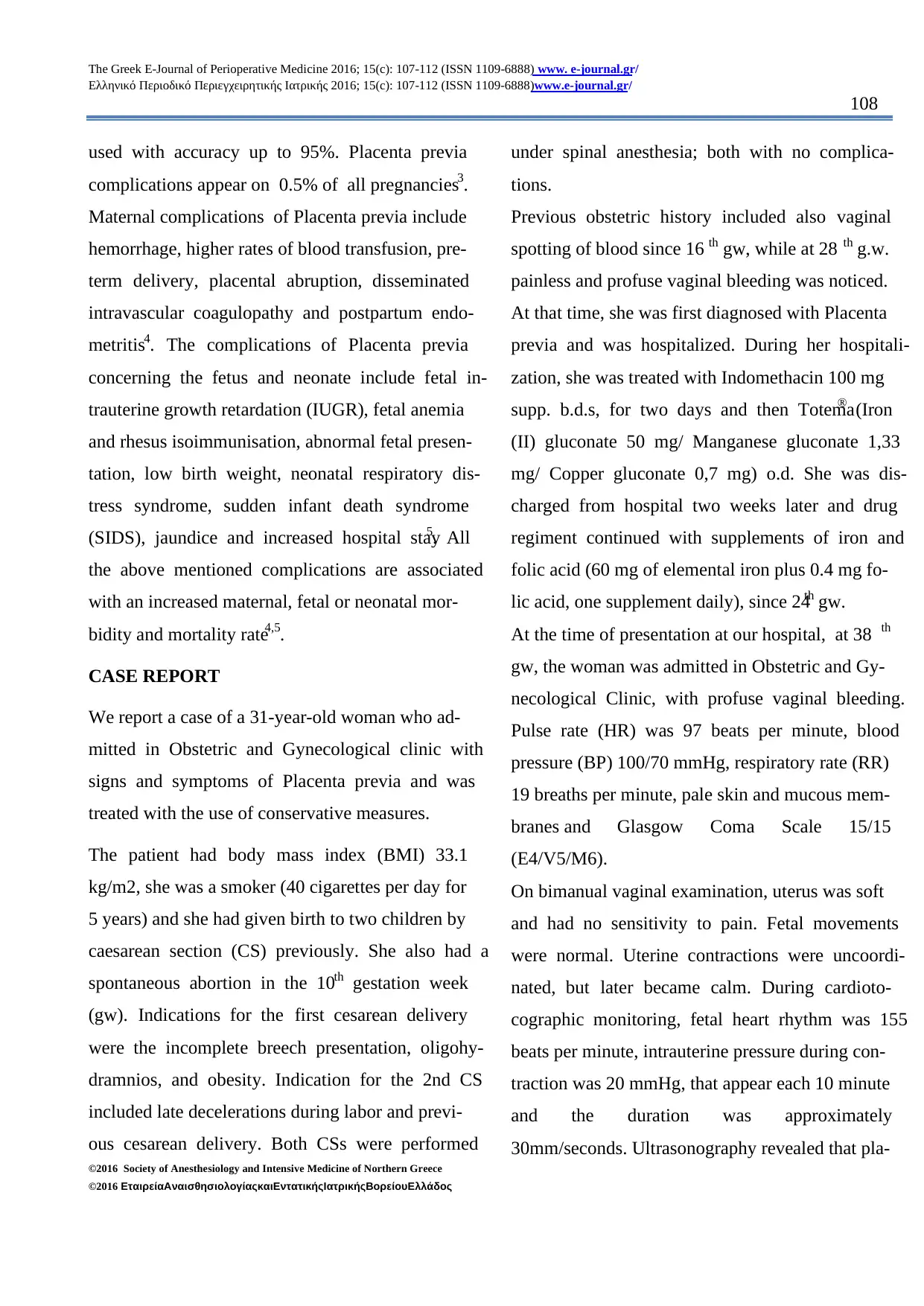
The Greek E-Journal of Perioperative Medicine 2016; 15(c): 107-112 (ISSN 1109-6888) www. e-journal.gr/
Ελληνικό Περιοδικό Περιεγχειρητικής Ιατρικής 2016; 15(c): 107-112 (ISSN 1109-6888)www.e-journal.gr/
108
©2016 Society of Anesthesiology and Intensive Medicine of Northern Greece
©2016 ΕταιρείαΑναισθησιολογίαςκαιΕντατικήςΙατρικήςΒορείουΕλλάδος
used with accuracy up to 95%. Placenta previa
complications appear on 0.5% of all pregnancies3.
Maternal complications of Placenta previa include
hemorrhage, higher rates of blood transfusion, pre-
term delivery, placental abruption, disseminated
intravascular coagulopathy and postpartum endo-
metritis4. The complications of Placenta previa
concerning the fetus and neonate include fetal in-
trauterine growth retardation (IUGR), fetal anemia
and rhesus isoimmunisation, abnormal fetal presen-
tation, low birth weight, neonatal respiratory dis-
tress syndrome, sudden infant death syndrome
(SIDS), jaundice and increased hospital stay5. All
the above mentioned complications are associated
with an increased maternal, fetal or neonatal mor-
bidity and mortality rate4,5.
CASE REPORT
We report a case of a 31-year-old woman who ad-
mitted in Obstetric and Gynecological clinic with
signs and symptoms of Placenta previa and was
treated with the use of conservative measures.
The patient had body mass index (BMI) 33.1
kg/m2, she was a smoker (40 cigarettes per day for
5 years) and she had given birth to two children by
caesarean section (CS) previously. She also had a
spontaneous abortion in the 10th gestation week
(gw). Indications for the first cesarean delivery
were the incomplete breech presentation, oligohy-
dramnios, and obesity. Indication for the 2nd CS
included late decelerations during labor and previ-
ous cesarean delivery. Both CSs were performed
under spinal anesthesia; both with no complica-
tions.
Previous obstetric history included also vaginal
spotting of blood since 16 th gw, while at 28 th g.w.
painless and profuse vaginal bleeding was noticed.
At that time, she was first diagnosed with Placenta
previa and was hospitalized. During her hospitali-
zation, she was treated with Indomethacin 100 mg
supp. b.d.s, for two days and then Totema® (Iron
(II) gluconate 50 mg/ Manganese gluconate 1,33
mg/ Copper gluconate 0,7 mg) o.d. She was dis-
charged from hospital two weeks later and drug
regiment continued with supplements of iron and
folic acid (60 mg of elemental iron plus 0.4 mg fo-
lic acid, one supplement daily), since 24th gw.
At the time of presentation at our hospital, at 38 th
gw, the woman was admitted in Obstetric and Gy-
necological Clinic, with profuse vaginal bleeding.
Pulse rate (HR) was 97 beats per minute, blood
pressure (BP) 100/70 mmHg, respiratory rate (RR)
19 breaths per minute, pale skin and mucous mem-
branes and Glasgow Coma Scale 15/15
(E4/V5/M6).
On bimanual vaginal examination, uterus was soft
and had no sensitivity to pain. Fetal movements
were normal. Uterine contractions were uncoordi-
nated, but later became calm. During cardioto-
cographic monitoring, fetal heart rhythm was 155
beats per minute, intrauterine pressure during con-
traction was 20 mmHg, that appear each 10 minute
and the duration was approximately
30mm/seconds. Ultrasonography revealed that pla-
Ελληνικό Περιοδικό Περιεγχειρητικής Ιατρικής 2016; 15(c): 107-112 (ISSN 1109-6888)www.e-journal.gr/
108
©2016 Society of Anesthesiology and Intensive Medicine of Northern Greece
©2016 ΕταιρείαΑναισθησιολογίαςκαιΕντατικήςΙατρικήςΒορείουΕλλάδος
used with accuracy up to 95%. Placenta previa
complications appear on 0.5% of all pregnancies3.
Maternal complications of Placenta previa include
hemorrhage, higher rates of blood transfusion, pre-
term delivery, placental abruption, disseminated
intravascular coagulopathy and postpartum endo-
metritis4. The complications of Placenta previa
concerning the fetus and neonate include fetal in-
trauterine growth retardation (IUGR), fetal anemia
and rhesus isoimmunisation, abnormal fetal presen-
tation, low birth weight, neonatal respiratory dis-
tress syndrome, sudden infant death syndrome
(SIDS), jaundice and increased hospital stay5. All
the above mentioned complications are associated
with an increased maternal, fetal or neonatal mor-
bidity and mortality rate4,5.
CASE REPORT
We report a case of a 31-year-old woman who ad-
mitted in Obstetric and Gynecological clinic with
signs and symptoms of Placenta previa and was
treated with the use of conservative measures.
The patient had body mass index (BMI) 33.1
kg/m2, she was a smoker (40 cigarettes per day for
5 years) and she had given birth to two children by
caesarean section (CS) previously. She also had a
spontaneous abortion in the 10th gestation week
(gw). Indications for the first cesarean delivery
were the incomplete breech presentation, oligohy-
dramnios, and obesity. Indication for the 2nd CS
included late decelerations during labor and previ-
ous cesarean delivery. Both CSs were performed
under spinal anesthesia; both with no complica-
tions.
Previous obstetric history included also vaginal
spotting of blood since 16 th gw, while at 28 th g.w.
painless and profuse vaginal bleeding was noticed.
At that time, she was first diagnosed with Placenta
previa and was hospitalized. During her hospitali-
zation, she was treated with Indomethacin 100 mg
supp. b.d.s, for two days and then Totema® (Iron
(II) gluconate 50 mg/ Manganese gluconate 1,33
mg/ Copper gluconate 0,7 mg) o.d. She was dis-
charged from hospital two weeks later and drug
regiment continued with supplements of iron and
folic acid (60 mg of elemental iron plus 0.4 mg fo-
lic acid, one supplement daily), since 24th gw.
At the time of presentation at our hospital, at 38 th
gw, the woman was admitted in Obstetric and Gy-
necological Clinic, with profuse vaginal bleeding.
Pulse rate (HR) was 97 beats per minute, blood
pressure (BP) 100/70 mmHg, respiratory rate (RR)
19 breaths per minute, pale skin and mucous mem-
branes and Glasgow Coma Scale 15/15
(E4/V5/M6).
On bimanual vaginal examination, uterus was soft
and had no sensitivity to pain. Fetal movements
were normal. Uterine contractions were uncoordi-
nated, but later became calm. During cardioto-
cographic monitoring, fetal heart rhythm was 155
beats per minute, intrauterine pressure during con-
traction was 20 mmHg, that appear each 10 minute
and the duration was approximately
30mm/seconds. Ultrasonography revealed that pla-
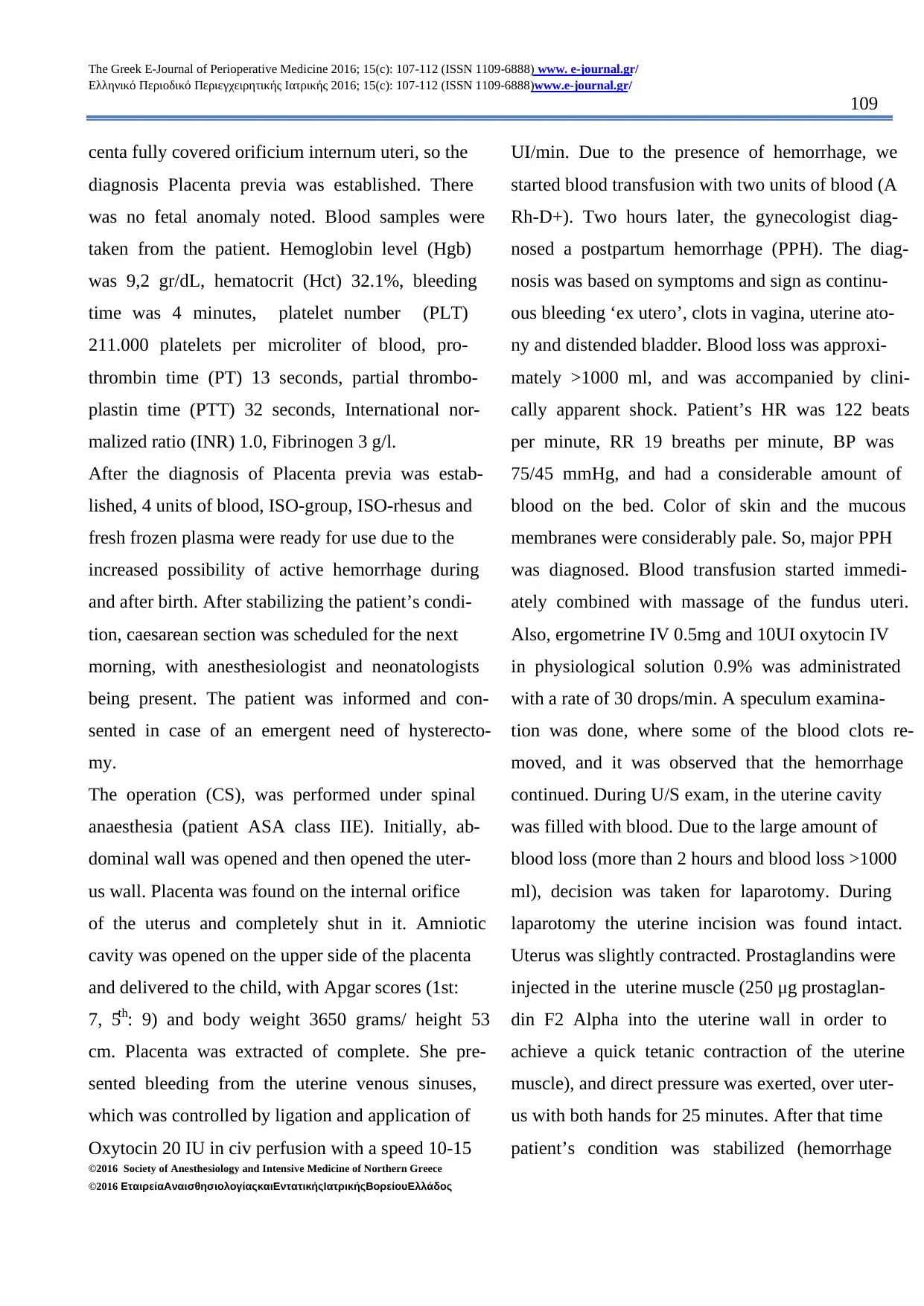
The Greek E-Journal of Perioperative Medicine 2016; 15(c): 107-112 (ISSN 1109-6888) www. e-journal.gr/
Ελληνικό Περιοδικό Περιεγχειρητικής Ιατρικής 2016; 15(c): 107-112 (ISSN 1109-6888)www.e-journal.gr/
109
©2016 Society of Anesthesiology and Intensive Medicine of Northern Greece
©2016 ΕταιρείαΑναισθησιολογίαςκαιΕντατικήςΙατρικήςΒορείουΕλλάδος
centa fully covered orificium internum uteri, so the
diagnosis Placenta previa was established. There
was no fetal anomaly noted. Blood samples were
taken from the patient. Hemoglobin level (Hgb)
was 9,2 gr/dL, hematocrit (Hct) 32.1%, bleeding
time was 4 minutes, platelet number (PLT)
211.000 platelets per microliter of blood, pro-
thrombin time (PT) 13 seconds, partial thrombo-
plastin time (PTT) 32 seconds, International nor-
malized ratio (INR) 1.0, Fibrinogen 3 g/l.
After the diagnosis of Placenta previa was estab-
lished, 4 units of blood, ISO-group, ISO-rhesus and
fresh frozen plasma were ready for use due to the
increased possibility of active hemorrhage during
and after birth. After stabilizing the patient’s condi-
tion, caesarean section was scheduled for the next
morning, with anesthesiologist and neonatologists
being present. The patient was informed and con-
sented in case of an emergent need of hysterecto-
my.
The operation (CS), was performed under spinal
anaesthesia (patient ASA class IIE). Initially, ab-
dominal wall was opened and then opened the uter-
us wall. Placenta was found on the internal orifice
of the uterus and completely shut in it. Amniotic
cavity was opened on the upper side of the placenta
and delivered to the child, with Apgar scores (1st:
7, 5th: 9) and body weight 3650 grams/ height 53
cm. Placenta was extracted of complete. She pre-
sented bleeding from the uterine venous sinuses,
which was controlled by ligation and application of
Oxytocin 20 IU in civ perfusion with a speed 10-15
UI/min. Due to the presence of hemorrhage, we
started blood transfusion with two units of blood (A
Rh-D+). Two hours later, the gynecologist diag-
nosed a postpartum hemorrhage (PPH). The diag-
nosis was based on symptoms and sign as continu-
ous bleeding ‘ex utero’, clots in vagina, uterine ato-
ny and distended bladder. Blood loss was approxi-
mately >1000 ml, and was accompanied by clini-
cally apparent shock. Patient’s HR was 122 beats
per minute, RR 19 breaths per minute, BP was
75/45 mmHg, and had a considerable amount of
blood on the bed. Color of skin and the mucous
membranes were considerably pale. So, major PPH
was diagnosed. Blood transfusion started immedi-
ately combined with massage of the fundus uteri.
Also, ergometrine IV 0.5mg and 10UI oxytocin IV
in physiological solution 0.9% was administrated
with a rate of 30 drops/min. A speculum examina-
tion was done, where some of the blood clots re-
moved, and it was observed that the hemorrhage
continued. During U/S exam, in the uterine cavity
was filled with blood. Due to the large amount of
blood loss (more than 2 hours and blood loss >1000
ml), decision was taken for laparotomy. During
laparotomy the uterine incision was found intact.
Uterus was slightly contracted. Prostaglandins were
injected in the uterine muscle (250 μg prostaglan-
din F2 Alpha into the uterine wall in order to
achieve a quick tetanic contraction of the uterine
muscle), and direct pressure was exerted, over uter-
us with both hands for 25 minutes. After that time
patient’s condition was stabilized (hemorrhage
Ελληνικό Περιοδικό Περιεγχειρητικής Ιατρικής 2016; 15(c): 107-112 (ISSN 1109-6888)www.e-journal.gr/
109
©2016 Society of Anesthesiology and Intensive Medicine of Northern Greece
©2016 ΕταιρείαΑναισθησιολογίαςκαιΕντατικήςΙατρικήςΒορείουΕλλάδος
centa fully covered orificium internum uteri, so the
diagnosis Placenta previa was established. There
was no fetal anomaly noted. Blood samples were
taken from the patient. Hemoglobin level (Hgb)
was 9,2 gr/dL, hematocrit (Hct) 32.1%, bleeding
time was 4 minutes, platelet number (PLT)
211.000 platelets per microliter of blood, pro-
thrombin time (PT) 13 seconds, partial thrombo-
plastin time (PTT) 32 seconds, International nor-
malized ratio (INR) 1.0, Fibrinogen 3 g/l.
After the diagnosis of Placenta previa was estab-
lished, 4 units of blood, ISO-group, ISO-rhesus and
fresh frozen plasma were ready for use due to the
increased possibility of active hemorrhage during
and after birth. After stabilizing the patient’s condi-
tion, caesarean section was scheduled for the next
morning, with anesthesiologist and neonatologists
being present. The patient was informed and con-
sented in case of an emergent need of hysterecto-
my.
The operation (CS), was performed under spinal
anaesthesia (patient ASA class IIE). Initially, ab-
dominal wall was opened and then opened the uter-
us wall. Placenta was found on the internal orifice
of the uterus and completely shut in it. Amniotic
cavity was opened on the upper side of the placenta
and delivered to the child, with Apgar scores (1st:
7, 5th: 9) and body weight 3650 grams/ height 53
cm. Placenta was extracted of complete. She pre-
sented bleeding from the uterine venous sinuses,
which was controlled by ligation and application of
Oxytocin 20 IU in civ perfusion with a speed 10-15
UI/min. Due to the presence of hemorrhage, we
started blood transfusion with two units of blood (A
Rh-D+). Two hours later, the gynecologist diag-
nosed a postpartum hemorrhage (PPH). The diag-
nosis was based on symptoms and sign as continu-
ous bleeding ‘ex utero’, clots in vagina, uterine ato-
ny and distended bladder. Blood loss was approxi-
mately >1000 ml, and was accompanied by clini-
cally apparent shock. Patient’s HR was 122 beats
per minute, RR 19 breaths per minute, BP was
75/45 mmHg, and had a considerable amount of
blood on the bed. Color of skin and the mucous
membranes were considerably pale. So, major PPH
was diagnosed. Blood transfusion started immedi-
ately combined with massage of the fundus uteri.
Also, ergometrine IV 0.5mg and 10UI oxytocin IV
in physiological solution 0.9% was administrated
with a rate of 30 drops/min. A speculum examina-
tion was done, where some of the blood clots re-
moved, and it was observed that the hemorrhage
continued. During U/S exam, in the uterine cavity
was filled with blood. Due to the large amount of
blood loss (more than 2 hours and blood loss >1000
ml), decision was taken for laparotomy. During
laparotomy the uterine incision was found intact.
Uterus was slightly contracted. Prostaglandins were
injected in the uterine muscle (250 μg prostaglan-
din F2 Alpha into the uterine wall in order to
achieve a quick tetanic contraction of the uterine
muscle), and direct pressure was exerted, over uter-
us with both hands for 25 minutes. After that time
patient’s condition was stabilized (hemorrhage
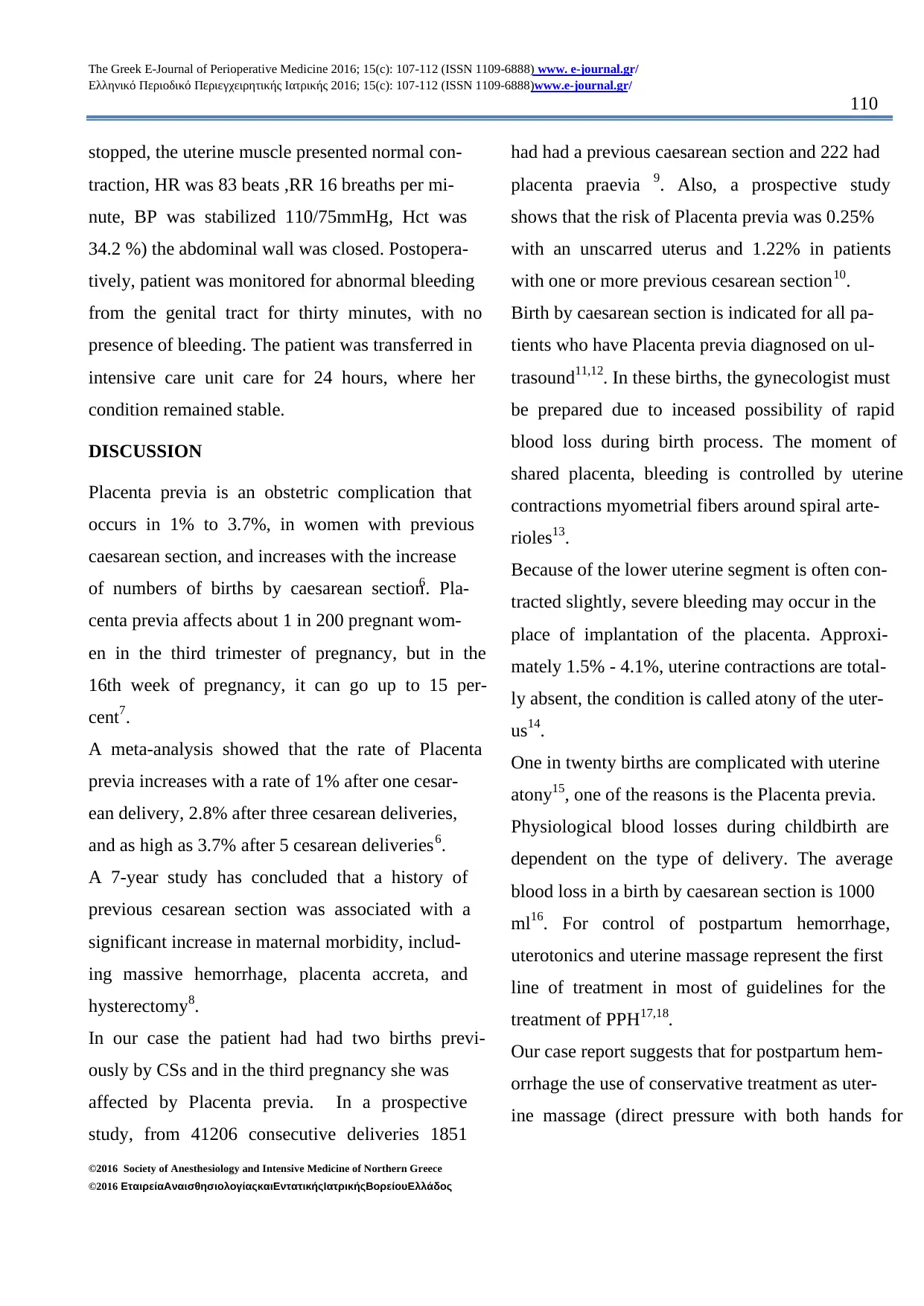
The Greek E-Journal of Perioperative Medicine 2016; 15(c): 107-112 (ISSN 1109-6888) www. e-journal.gr/
Ελληνικό Περιοδικό Περιεγχειρητικής Ιατρικής 2016; 15(c): 107-112 (ISSN 1109-6888)www.e-journal.gr/
110
©2016 Society of Anesthesiology and Intensive Medicine of Northern Greece
©2016 ΕταιρείαΑναισθησιολογίαςκαιΕντατικήςΙατρικήςΒορείουΕλλάδος
stopped, the uterine muscle presented normal con-
traction, HR was 83 beats ,RR 16 breaths per mi-
nute, BP was stabilized 110/75mmHg, Hct was
34.2 %) the abdominal wall was closed. Postopera-
tively, patient was monitored for abnormal bleeding
from the genital tract for thirty minutes, with no
presence of bleeding. The patient was transferred in
intensive care unit care for 24 hours, where her
condition remained stable.
DISCUSSION
Placenta previa is an obstetric complication that
occurs in 1% to 3.7%, in women with previous
caesarean section, and increases with the increase
of numbers of births by caesarean section6. Pla-
centa previa affects about 1 in 200 pregnant wom-
en in the third trimester of pregnancy, but in the
16th week of pregnancy, it can go up to 15 per-
cent7.
A meta-analysis showed that the rate of Placenta
previa increases with a rate of 1% after one cesar-
ean delivery, 2.8% after three cesarean deliveries,
and as high as 3.7% after 5 cesarean deliveries6.
A 7-year study has concluded that a history of
previous cesarean section was associated with a
significant increase in maternal morbidity, includ-
ing massive hemorrhage, placenta accreta, and
hysterectomy8.
In our case the patient had had two births previ-
ously by CSs and in the third pregnancy she was
affected by Placenta previa. In a prospective
study, from 41206 consecutive deliveries 1851
had had a previous caesarean section and 222 had
placenta praevia 9. Also, a prospective study
shows that the risk of Placenta previa was 0.25%
with an unscarred uterus and 1.22% in patients
with one or more previous cesarean section10.
Birth by caesarean section is indicated for all pa-
tients who have Placenta previa diagnosed on ul-
trasound11,12. In these births, the gynecologist must
be prepared due to inceased possibility of rapid
blood loss during birth process. The moment of
shared placenta, bleeding is controlled by uterine
contractions myometrial fibers around spiral arte-
rioles13.
Because of the lower uterine segment is often con-
tracted slightly, severe bleeding may occur in the
place of implantation of the placenta. Approxi-
mately 1.5% - 4.1%, uterine contractions are total-
ly absent, the condition is called atony of the uter-
us14.
One in twenty births are complicated with uterine
atony15, one of the reasons is the Placenta previa.
Physiological blood losses during childbirth are
dependent on the type of delivery. The average
blood loss in a birth by caesarean section is 1000
ml16. For control of postpartum hemorrhage,
uterotonics and uterine massage represent the first
line of treatment in most of guidelines for the
treatment of PPH17,18.
Our case report suggests that for postpartum hem-
orrhage the use of conservative treatment as uter-
ine massage (direct pressure with both hands for
Ελληνικό Περιοδικό Περιεγχειρητικής Ιατρικής 2016; 15(c): 107-112 (ISSN 1109-6888)www.e-journal.gr/
110
©2016 Society of Anesthesiology and Intensive Medicine of Northern Greece
©2016 ΕταιρείαΑναισθησιολογίαςκαιΕντατικήςΙατρικήςΒορείουΕλλάδος
stopped, the uterine muscle presented normal con-
traction, HR was 83 beats ,RR 16 breaths per mi-
nute, BP was stabilized 110/75mmHg, Hct was
34.2 %) the abdominal wall was closed. Postopera-
tively, patient was monitored for abnormal bleeding
from the genital tract for thirty minutes, with no
presence of bleeding. The patient was transferred in
intensive care unit care for 24 hours, where her
condition remained stable.
DISCUSSION
Placenta previa is an obstetric complication that
occurs in 1% to 3.7%, in women with previous
caesarean section, and increases with the increase
of numbers of births by caesarean section6. Pla-
centa previa affects about 1 in 200 pregnant wom-
en in the third trimester of pregnancy, but in the
16th week of pregnancy, it can go up to 15 per-
cent7.
A meta-analysis showed that the rate of Placenta
previa increases with a rate of 1% after one cesar-
ean delivery, 2.8% after three cesarean deliveries,
and as high as 3.7% after 5 cesarean deliveries6.
A 7-year study has concluded that a history of
previous cesarean section was associated with a
significant increase in maternal morbidity, includ-
ing massive hemorrhage, placenta accreta, and
hysterectomy8.
In our case the patient had had two births previ-
ously by CSs and in the third pregnancy she was
affected by Placenta previa. In a prospective
study, from 41206 consecutive deliveries 1851
had had a previous caesarean section and 222 had
placenta praevia 9. Also, a prospective study
shows that the risk of Placenta previa was 0.25%
with an unscarred uterus and 1.22% in patients
with one or more previous cesarean section10.
Birth by caesarean section is indicated for all pa-
tients who have Placenta previa diagnosed on ul-
trasound11,12. In these births, the gynecologist must
be prepared due to inceased possibility of rapid
blood loss during birth process. The moment of
shared placenta, bleeding is controlled by uterine
contractions myometrial fibers around spiral arte-
rioles13.
Because of the lower uterine segment is often con-
tracted slightly, severe bleeding may occur in the
place of implantation of the placenta. Approxi-
mately 1.5% - 4.1%, uterine contractions are total-
ly absent, the condition is called atony of the uter-
us14.
One in twenty births are complicated with uterine
atony15, one of the reasons is the Placenta previa.
Physiological blood losses during childbirth are
dependent on the type of delivery. The average
blood loss in a birth by caesarean section is 1000
ml16. For control of postpartum hemorrhage,
uterotonics and uterine massage represent the first
line of treatment in most of guidelines for the
treatment of PPH17,18.
Our case report suggests that for postpartum hem-
orrhage the use of conservative treatment as uter-
ine massage (direct pressure with both hands for
Secure Best Marks with AI Grader
Need help grading? Try our AI Grader for instant feedback on your assignments.
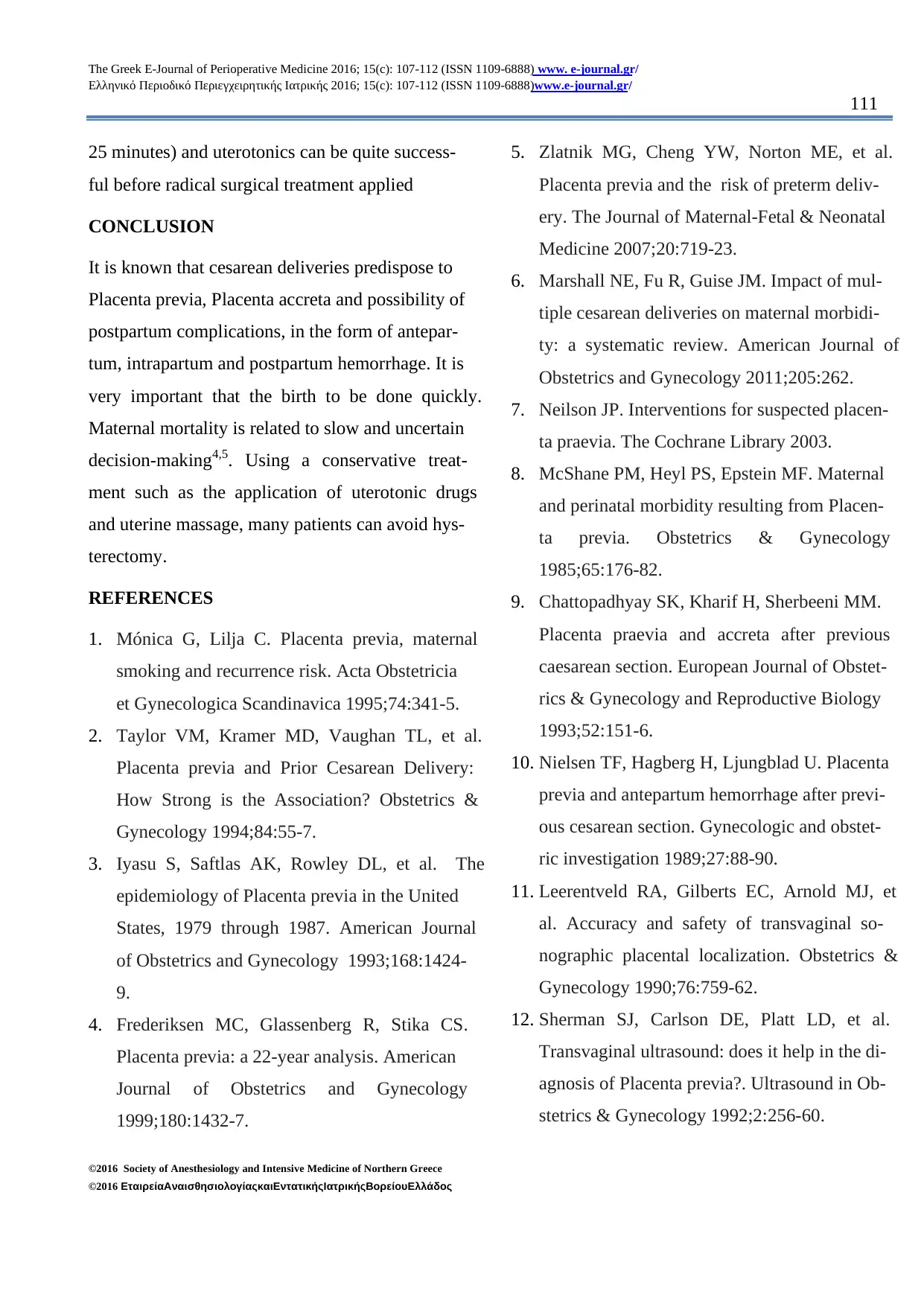
The Greek E-Journal of Perioperative Medicine 2016; 15(c): 107-112 (ISSN 1109-6888) www. e-journal.gr/
Ελληνικό Περιοδικό Περιεγχειρητικής Ιατρικής 2016; 15(c): 107-112 (ISSN 1109-6888)www.e-journal.gr/
111
©2016 Society of Anesthesiology and Intensive Medicine of Northern Greece
©2016 ΕταιρείαΑναισθησιολογίαςκαιΕντατικήςΙατρικήςΒορείουΕλλάδος
25 minutes) and uterotonics can be quite success-
ful before radical surgical treatment applied
CONCLUSION
It is known that cesarean deliveries predispose to
Placenta previa, Placenta accreta and possibility of
postpartum complications, in the form of antepar-
tum, intrapartum and postpartum hemorrhage. It is
very important that the birth to be done quickly.
Maternal mortality is related to slow and uncertain
decision-making4,5. Using a conservative treat-
ment such as the application of uterotonic drugs
and uterine massage, many patients can avoid hys-
terectomy.
REFERENCES
1. Mónica G, Lilja C. Placenta previa, maternal
smoking and recurrence risk. Acta Obstetricia
et Gynecologica Scandinavica 1995;74:341-5.
2. Taylor VM, Kramer MD, Vaughan TL, et al.
Placenta previa and Prior Cesarean Delivery:
How Strong is the Association? Obstetrics &
Gynecology 1994;84:55-7.
3. Iyasu S, Saftlas AK, Rowley DL, et al. The
epidemiology of Placenta previa in the United
States, 1979 through 1987. American Journal
of Obstetrics and Gynecology 1993;168:1424-
9.
4. Frederiksen MC, Glassenberg R, Stika CS.
Placenta previa: a 22-year analysis. American
Journal of Obstetrics and Gynecology
1999;180:1432-7.
5. Zlatnik MG, Cheng YW, Norton ME, et al.
Placenta previa and the risk of preterm deliv-
ery. The Journal of Maternal-Fetal & Neonatal
Medicine 2007;20:719-23.
6. Marshall NE, Fu R, Guise JM. Impact of mul-
tiple cesarean deliveries on maternal morbidi-
ty: a systematic review. American Journal of
Obstetrics and Gynecology 2011;205:262.
7. Neilson JP. Interventions for suspected placen-
ta praevia. The Cochrane Library 2003.
8. McShane PM, Heyl PS, Epstein MF. Maternal
and perinatal morbidity resulting from Placen-
ta previa. Obstetrics & Gynecology
1985;65:176-82.
9. Chattopadhyay SK, Kharif H, Sherbeeni MM.
Placenta praevia and accreta after previous
caesarean section. European Journal of Obstet-
rics & Gynecology and Reproductive Biology
1993;52:151-6.
10. Nielsen TF, Hagberg H, Ljungblad U. Placenta
previa and antepartum hemorrhage after previ-
ous cesarean section. Gynecologic and obstet-
ric investigation 1989;27:88-90.
11. Leerentveld RA, Gilberts EC, Arnold MJ, et
al. Accuracy and safety of transvaginal so-
nographic placental localization. Obstetrics &
Gynecology 1990;76:759-62.
12. Sherman SJ, Carlson DE, Platt LD, et al.
Transvaginal ultrasound: does it help in the di-
agnosis of Placenta previa?. Ultrasound in Ob-
stetrics & Gynecology 1992;2:256-60.
Ελληνικό Περιοδικό Περιεγχειρητικής Ιατρικής 2016; 15(c): 107-112 (ISSN 1109-6888)www.e-journal.gr/
111
©2016 Society of Anesthesiology and Intensive Medicine of Northern Greece
©2016 ΕταιρείαΑναισθησιολογίαςκαιΕντατικήςΙατρικήςΒορείουΕλλάδος
25 minutes) and uterotonics can be quite success-
ful before radical surgical treatment applied
CONCLUSION
It is known that cesarean deliveries predispose to
Placenta previa, Placenta accreta and possibility of
postpartum complications, in the form of antepar-
tum, intrapartum and postpartum hemorrhage. It is
very important that the birth to be done quickly.
Maternal mortality is related to slow and uncertain
decision-making4,5. Using a conservative treat-
ment such as the application of uterotonic drugs
and uterine massage, many patients can avoid hys-
terectomy.
REFERENCES
1. Mónica G, Lilja C. Placenta previa, maternal
smoking and recurrence risk. Acta Obstetricia
et Gynecologica Scandinavica 1995;74:341-5.
2. Taylor VM, Kramer MD, Vaughan TL, et al.
Placenta previa and Prior Cesarean Delivery:
How Strong is the Association? Obstetrics &
Gynecology 1994;84:55-7.
3. Iyasu S, Saftlas AK, Rowley DL, et al. The
epidemiology of Placenta previa in the United
States, 1979 through 1987. American Journal
of Obstetrics and Gynecology 1993;168:1424-
9.
4. Frederiksen MC, Glassenberg R, Stika CS.
Placenta previa: a 22-year analysis. American
Journal of Obstetrics and Gynecology
1999;180:1432-7.
5. Zlatnik MG, Cheng YW, Norton ME, et al.
Placenta previa and the risk of preterm deliv-
ery. The Journal of Maternal-Fetal & Neonatal
Medicine 2007;20:719-23.
6. Marshall NE, Fu R, Guise JM. Impact of mul-
tiple cesarean deliveries on maternal morbidi-
ty: a systematic review. American Journal of
Obstetrics and Gynecology 2011;205:262.
7. Neilson JP. Interventions for suspected placen-
ta praevia. The Cochrane Library 2003.
8. McShane PM, Heyl PS, Epstein MF. Maternal
and perinatal morbidity resulting from Placen-
ta previa. Obstetrics & Gynecology
1985;65:176-82.
9. Chattopadhyay SK, Kharif H, Sherbeeni MM.
Placenta praevia and accreta after previous
caesarean section. European Journal of Obstet-
rics & Gynecology and Reproductive Biology
1993;52:151-6.
10. Nielsen TF, Hagberg H, Ljungblad U. Placenta
previa and antepartum hemorrhage after previ-
ous cesarean section. Gynecologic and obstet-
ric investigation 1989;27:88-90.
11. Leerentveld RA, Gilberts EC, Arnold MJ, et
al. Accuracy and safety of transvaginal so-
nographic placental localization. Obstetrics &
Gynecology 1990;76:759-62.
12. Sherman SJ, Carlson DE, Platt LD, et al.
Transvaginal ultrasound: does it help in the di-
agnosis of Placenta previa?. Ultrasound in Ob-
stetrics & Gynecology 1992;2:256-60.
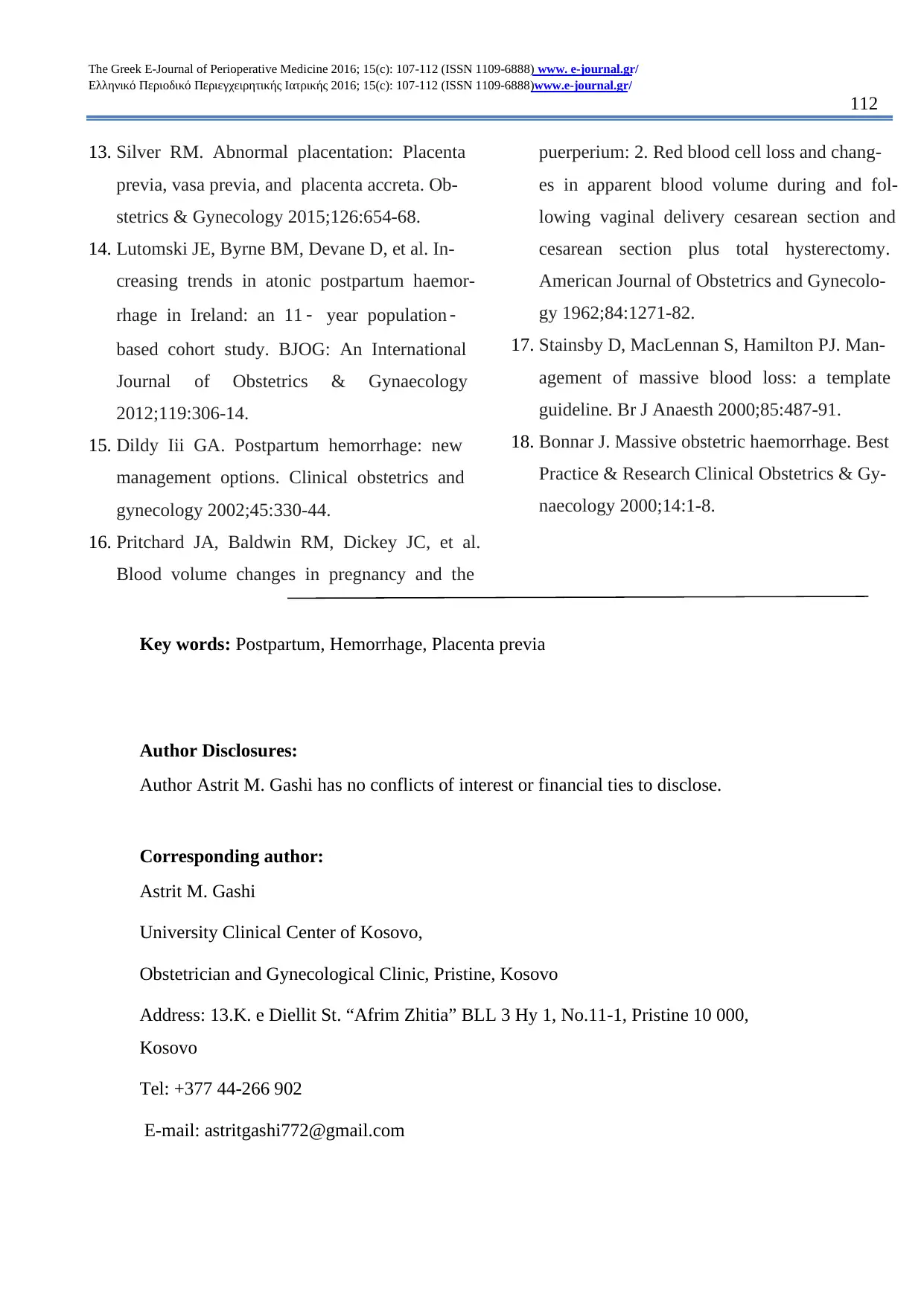
The Greek E-Journal of Perioperative Medicine 2016; 15(c): 107-112 (ISSN 1109-6888) www. e-journal.gr/
Ελληνικό Περιοδικό Περιεγχειρητικής Ιατρικής 2016; 15(c): 107-112 (ISSN 1109-6888)www.e-journal.gr/
112
©2016 Society of Anesthesiology and Intensive Medicine of Northern Greece
©2016 ΕταιρείαΑναισθησιολογίαςκαιΕντατικήςΙατρικήςΒορείουΕλλάδος
13. Silver RM. Abnormal placentation: Placenta
previa, vasa previa, and placenta accreta. Ob-
stetrics & Gynecology 2015;126:654-68.
14. Lutomski JE, Byrne BM, Devane D, et al. In-
creasing trends in atonic postpartum haemor-
rhage in Ireland: an 11 ‐ year population ‐
based cohort study. BJOG: An International
Journal of Obstetrics & Gynaecology
2012;119:306-14.
15. Dildy Iii GA. Postpartum hemorrhage: new
management options. Clinical obstetrics and
gynecology 2002;45:330-44.
16. Pritchard JA, Baldwin RM, Dickey JC, et al.
Blood volume changes in pregnancy and the
puerperium: 2. Red blood cell loss and chang-
es in apparent blood volume during and fol-
lowing vaginal delivery cesarean section and
cesarean section plus total hysterectomy.
American Journal of Obstetrics and Gynecolo-
gy 1962;84:1271-82.
17. Stainsby D, MacLennan S, Hamilton PJ. Man-
agement of massive blood loss: a template
guideline. Br J Anaesth 2000;85:487-91.
18. Bonnar J. Massive obstetric haemorrhage. Best
Practice & Research Clinical Obstetrics & Gy-
naecology 2000;14:1-8.
Key words: Postpartum, Hemorrhage, Placenta previa
Author Disclosures:
Author Astrit M. Gashi has no conflicts of interest or financial ties to disclose.
Corresponding author:
Astrit M. Gashi
University Clinical Center of Kosovo,
Obstetrician and Gynecological Clinic, Pristine, Kosovo
Address: 13.K. e Diellit St. “Afrim Zhitia” BLL 3 Hy 1, No.11-1, Pristine 10 000,
Kosovo
Tel: +377 44-266 902
E-mail: astritgashi772@gmail.com
Ελληνικό Περιοδικό Περιεγχειρητικής Ιατρικής 2016; 15(c): 107-112 (ISSN 1109-6888)www.e-journal.gr/
112
©2016 Society of Anesthesiology and Intensive Medicine of Northern Greece
©2016 ΕταιρείαΑναισθησιολογίαςκαιΕντατικήςΙατρικήςΒορείουΕλλάδος
13. Silver RM. Abnormal placentation: Placenta
previa, vasa previa, and placenta accreta. Ob-
stetrics & Gynecology 2015;126:654-68.
14. Lutomski JE, Byrne BM, Devane D, et al. In-
creasing trends in atonic postpartum haemor-
rhage in Ireland: an 11 ‐ year population ‐
based cohort study. BJOG: An International
Journal of Obstetrics & Gynaecology
2012;119:306-14.
15. Dildy Iii GA. Postpartum hemorrhage: new
management options. Clinical obstetrics and
gynecology 2002;45:330-44.
16. Pritchard JA, Baldwin RM, Dickey JC, et al.
Blood volume changes in pregnancy and the
puerperium: 2. Red blood cell loss and chang-
es in apparent blood volume during and fol-
lowing vaginal delivery cesarean section and
cesarean section plus total hysterectomy.
American Journal of Obstetrics and Gynecolo-
gy 1962;84:1271-82.
17. Stainsby D, MacLennan S, Hamilton PJ. Man-
agement of massive blood loss: a template
guideline. Br J Anaesth 2000;85:487-91.
18. Bonnar J. Massive obstetric haemorrhage. Best
Practice & Research Clinical Obstetrics & Gy-
naecology 2000;14:1-8.
Key words: Postpartum, Hemorrhage, Placenta previa
Author Disclosures:
Author Astrit M. Gashi has no conflicts of interest or financial ties to disclose.
Corresponding author:
Astrit M. Gashi
University Clinical Center of Kosovo,
Obstetrician and Gynecological Clinic, Pristine, Kosovo
Address: 13.K. e Diellit St. “Afrim Zhitia” BLL 3 Hy 1, No.11-1, Pristine 10 000,
Kosovo
Tel: +377 44-266 902
E-mail: astritgashi772@gmail.com
1 out of 6
Your All-in-One AI-Powered Toolkit for Academic Success.
+13062052269
info@desklib.com
Available 24*7 on WhatsApp / Email
![[object Object]](/_next/static/media/star-bottom.7253800d.svg)
Unlock your academic potential
© 2024 | Zucol Services PVT LTD | All rights reserved.